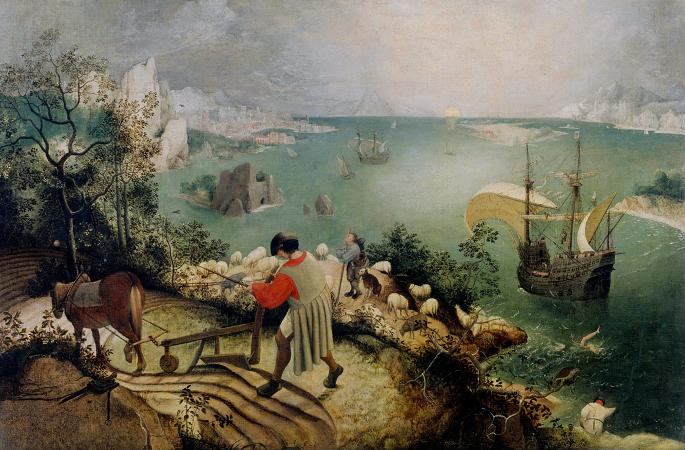Jacob Grimmer (c1526 - c1590). Jacob Grimmer was a Flemish landscape painter and draughtsman. His rural scenes and landscapes of views around Antwerp marked an important development in 16th century Flemish landscape painting away from the world landscape with its fantastic panoramas and whimsically-shaped gigantic rocks towards greater simplicity and authenticity. His work influenced the next generation of Flemish landscape painters. Grimmer was a capable colorist who was able to create harmonic landscapes by using realistic colours and atmospheric values effectively. Jacob Grimmer was born in Antwerp as the son of the small merchant Nicolaas and Elisabeth Cops. According to the early Flemish biographer Karel van Mander, Grimmer first learned to paint landscapes from Matthys Cock and later from Christian van den Queborn, both of Antwerp. There are no written sources, which confirm these apprenticeships. Landscape with figures The only documentary evidence relating to Grimmer's training is his registration in 1539 under the name Iaques Grimmaer in the liggeren of the Antwerp Guild of Saint Luke as a student of Gabriel Bouwens. It is therefore not certain that Grimmer in fact was a pupil of Matthys Cock and Christian van den Queborn. Grimmer became a master in the Antwerp Guild of Saint Luke in 1547. Grimmer married Lucia van de Wouwer in April 1548. Of the four children born out of this marriage Abel became an important landscape and architectural painter. There is some disagreement among art historians as to whether or not Grimmer traveled to Italy as many of his artist contemporaries did. He bought a house in the centre of Antwerp where he set up his studio. He was known for painting after nature in the areas around Antwerp. As early as 1550 Jacob Grimmer was praised by the famous Italian art historian Vasari as one of the best landscape painters of his time. Karel van Mander described Grimmer as such an outstanding landscape painter that in some respects I do not know a better one, so lively and lovely were his skies. Grimmer's art was appreciated not only by his contemporaries but also by artists of the next century. Both Pieter Lastman and his famous pupil, Rembrandt, owned landscapes by Grimmer. Rembrandt's inventory of 1656 included a winter landscape by Jacob Grimmer. A winter landscape with a village, skaters on a frozen river, and hunters in the foreground Jacob Grimmer was an active member of the local chamber of rhetoric Violieren where he was celebrated as a poet and author of comic writings. He died before May 1590 in Antwerp. Jacob Grimmer was principally a painter of landscapes and winter scenes although he also painted some religiously themed works such as the Tower of Babel and genre works. He often returned to the subject of the Four Seasons and the Twelve Months. His earliest dated work was dated to 1546 and his latest dated work to 1589. He was known for working directly from nature as was reported by Karel van Mander. His output was large as he relied on a large workshop, which produced small-scale panels in a standardized production process. His son Abel further streamlined this mass production process. Jacob has often been regarded as an imitator of Pieter Brueghel the Elder who recreated Brueghel's artistic innovations on small panels and supplied these to the market at low prices. Grimmer's landscapes did at the same time constitute a further development in the landscape genre. Grimmer broke away from the earlier Flemish tradition of the so-called world landscape initiated by Joachim Patinir. The term world landscape is used in art historical literature for a landscape composition, which shows an imaginary panoramic landscape with mountains and lowlands, water, and buildings from an elevated viewpoint and usually includes a small-scale Biblical or historical narrative but the figures comprising this narrative element are dwarfed by their surroundings.
more...












